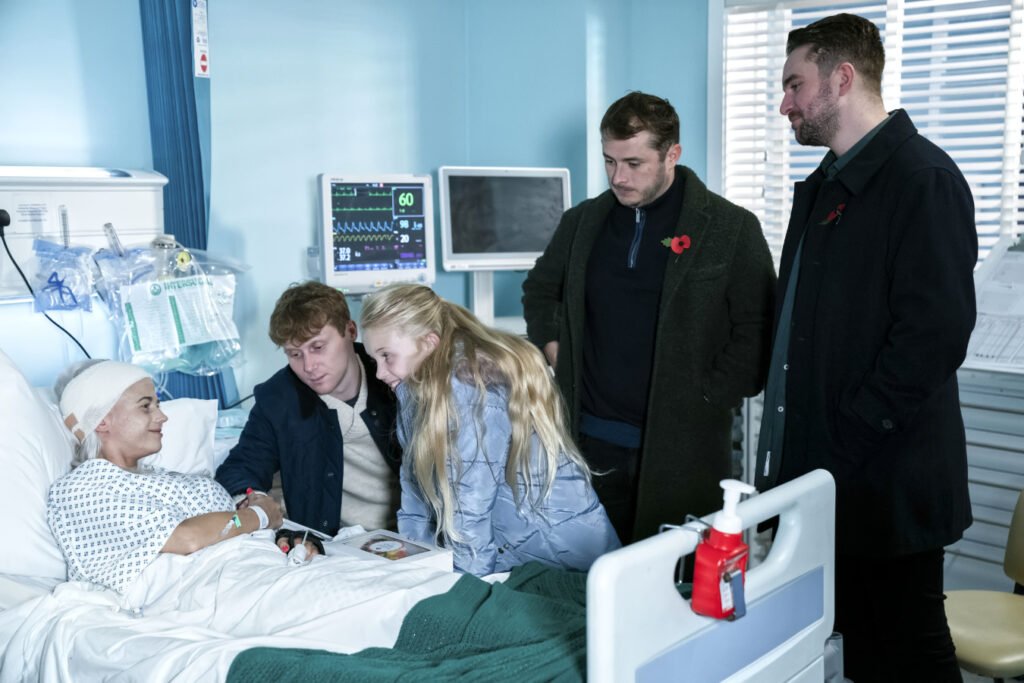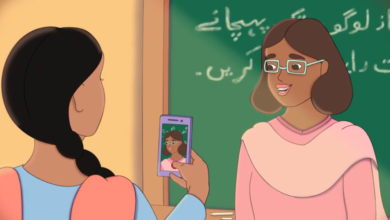To help raise awareness for Brain Tumour Awareness Month, Brain Tumour Research has teamed up with BBC One soap opera Eastenders to create a story in which the character, Lola Pearce, is diagnosed with a malignant brain tumour.
I was diagnosed with a brain tumour when I was 17 and was too young to truly understand what this meant or how it might affect me in the long term.
Fortunately, I joined the Brain Tumour Charity as a young ambassador and talked to other young adults who’ve been diagnosed with brain tumours. But I couldn’t help but recognise the stark underrepresentation of brain tumour stories in the media despite it being the biggest cancer killer in people under 40.
In fact, the only time I’d heard the words “brain tumour” used in films, TV, or literature was in reference to one’s seemingly socially unacceptable behaviour.
For example, in the film Midnight in Paris, Inez (Rachel McAdams) accuses Gil (Owen Wilson) of having a brain tumour because she believes that he had gone insane for claiming that each night at midnight, he was meeting various dead literary icons like F. Scott Fitzgerald. This always made me cringe as she uses the little knowledge she has of brain tumours to judge someone.
However, in light of Brain Tumour Awareness Month this month, British soap, Eastenders, is working alongside Brain Tumour Research and Macmillan Cancer Support to create a brain tumour storyline.
The storyline depicts the character, Lola Pearce, played by Danielle Harold, dealing with a brain tumour diagnosis. Harold has played Lola since 2011 and has been at the centre of other hard-hitting storylines.
The Storyline
The storyline began airing in autumn wherein Lola was told by a doctor that she had a glioblastoma (GBM) after she suffered a seizure. Glioblastomas are a form of brain cancer.
The scenes show Lola having an MRI scan to find out why she had had a seizure. Watching Lola prepare to enter the scanning tunnel was all too relatable to me and I loved how realistic the portrayal was.
Afterwards, the doctor told her “We found something on your scan that concerns us […] the scan shows a tumour.” “There’s a strong possibility that this tumour is cancer.”
Lola later finds out that her tumour is a “glioblastoma multiforme, which is a fast-growing and spreading tumour.”
Initially, Lola, an outgoing beautician, wanted to keep her diagnosis from her young daughter, the equally outgoing Lexi Pearce (Isabella Brown), believing that she’d go into the hospital to have the tumour removed and “then have a bit of chemo if it’s not all gone.” However, upon finding out that her tumour is life-threatening, Lexi soon learned about her mother’s diagnosis.
To help create this part of the storyline, Eastenders worked with a charity supporting young people affected by family health crises to prepare the scenes in which Lexi finds out about her mother’s diagnosis.
The show said it teamed up with the Hope Support Services charity for these scenes to ensure that the storyline is “portrayed as realistically and as sensitively as possible for all children who have parents experiencing a terminal illness.”
It has since followed Lola’s story and portrayed her family learning how to cope with her diagnosis and it’s hinted that Lola will not survive.
In more recent episodes earlier this month, viewers see Lola experiencing some of the lesser-known symptoms such as mind blackouts which are more formally known as absence seizures.
In one scene we watch as Lola blanks out for a few seconds whilst listening to Lexi talk to her about a charity event that she wants to hold to raise awareness.
According to the Mayo Clinic, “Someone having an absence seizure may look like he or she is staring blankly into space for a few seconds. Then, there is a quick return to a normal level of alertness.”
As someone who frequently experiences absence seizures and tends to zone out mid-conversation and mid-action, I loved that Eastenders has made viewers aware of this brain tumour symptom as I’ve often worried that people around me in these moments have judged me and questioned my ability to do things.
What is a Glioblastoma?
According to Dr Karen Noble, director of research, policy and innovation at Brain Tumour Research, “Glioblastoma (GBM) is one of more than 100 types of brain tumour.”
“This is a highly varied tumour type, which contains a mixture of different types of ‘glial’ brain cells, hence the name glioblastoma. GBM very rarely spreads outside of the brain, spine, or central nervous system to other parts of the body.”
“The way the tumour looks on a brain scan can also indicate the type and grade of a tumour, but it is not as reliable as looking at the cells themselves,” she continues.
Glioblastomas are classified as the most “severe and fastest-growing grade” tumour (grade 4), and it is hinted that Lola will not survive her diagnosis.
“Brain tumours kill more children and adults under the age of 40 than any other cancer,” Noble says, and the survival rate for glioblastoma is lower than many other cancers.
“Sadly, the average prognosis is devastatingly short, with many patients living for just 12 to 18 months. Just 25% of glioblastoma patients survive for more than a year and just 5% survive more than five years.”
The Symptoms
According to Noble, “Symptoms of glioblastoma tend to develop gradually over a period of six weeks or so.”
“Patients might present at their GP with seemingly minor complaints – and these can include headaches caused by pressure, seizures, focal symptoms including visual disturbances, problems with balance, or numbness/tingling down one side in the arms or legs,” she continues.”
Treatments
Noble says that “there is no cure for glioblastoma tumours and treatment options are very limited, with most patients undergoing surgery, depending on the tumour’s location, followed by radiotherapy and chemotherapy.”
Despite researchers facing challenges due to the complexity around the growth of these tumours, according to Noble, “earlier this year, the Brain Tumour Research Centre of Excellence at Imperial College London announced a significant breakthrough, which could dramatically improve the effectiveness of radiotherapy for GBM patients in the future.”
Outcome of the Storyline
Speaking of the scenes in which viewers see Lexi dealing with Lola’s diagnosis, Lorna Russell, safeguarding lead at Hope Support Services, said, “It’s been great to work with Danielle (Lola) and Isabella (Lexi) on this storyline – lots of families will understand how distressing it can be for children when someone they love has cancer, so we’re pleased to see EastEnders focusing on how Lexi is affected by Lola’s brain tumour.”
Harold herself has said that portraying Lola’s tumour experiences is a “massive responsibility” as it has “affected so many people”.
She’s also said, “It means so much to be trusted with a storyline like this – one that’s close to many people’s hearts. Sadly, many of our viewers will be able to relate to Lola’s story, and it’s been heartbreaking to speak to the families affected by brain tumours and hear their stories. They’ve been so amazing in sharing their experiences with me, and I’m so lucky to have them. I wouldn’t be able to do this storyline without their support.”

In an episode on the One Show, Harold said, “Especially me starting the story, I didn’t realise just how many that it does [affect] and just how little awareness there is and just how little funding there actually is for brain tumour research as well.
30-year-old mum, Elizabeth Mahon, who was diagnosed with GBM last year when she was 20 weeks pregnant, has also praised EastEnders’ storyline. She said, “It all came flooding back when Lola was told she had a brain tumour, how it was such a massive shock, and then the sitting in the hospital and waiting for results.”
“Danielle Harold plays the role so well, it’s scarily accurate. I talk about the storyline with my husband, Danny, and my parents.”
“My mum got upset while watching it, but it’s so important to raise awareness because people don’t understand how quickly brain tumours change people’s lives.”
Meanwhile, the head of PR and Communications at Brain Tumour Research, Sue Castle-Smith, said, “We’re incredibly grateful to EastEnders for helping to raise awareness of brain tumours, which kill more children and adults under the age of 40 than any other cancer.
“Sadly, Lola’s story will be all too familiar to one in three people who know someone affected by this devastating disease.
“Increased awareness is vital as we campaign for the government and the larger cancer charities to invest more to improve outcomes for patients and ultimately to find a cure.”
Brain Tumour Research helps to refund dedicated research centres in the UK through charity work. It is also “the driving force behind the call for a national annual spend of £35 million in order to improve survival rates and patient outcomes in line with other cancers such as breast cancer and leukaemia and is also campaigning for greater repurposing of drugs.”
Read More:
UK Health Agency issues back to school advice amid uptick in flu, Covid-19, and Scarlet fever
Ozone layer slowly healing, hole to mend completely by 2066
Amsterdam’s RESILIO blue green roofs offer solution to urban flooding, heat island effect









